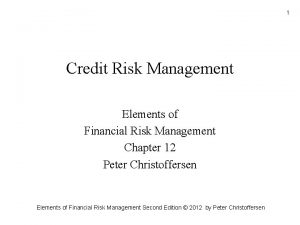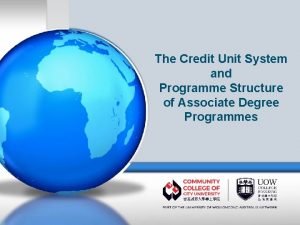UNIT 15 FINANCIAL MANAGEMENT Unit code M5080527 Credit


















![REFERENCES � Knowhownonprofit. org. (2018). The basics of financial management — Knowhow Nonprofit. [online] REFERENCES � Knowhownonprofit. org. (2018). The basics of financial management — Knowhow Nonprofit. [online]](https://slidetodoc.com/presentation_image_h2/cd1273d1ad67a599816702bcf6dcdb76/image-19.jpg)

- Slides: 20

UNIT 15: FINANCIAL MANAGEMENT Unit code M/508/0527 Credit value 15

UNIT 15: FINANCIAL MANAGEMENT �Learning Outcome 2: Analyse financial management principles which are used to support effective financial strategies.

THE BASIC SYLLABUS � 1 Apply different approaches used to support effective decision-making. � 2 Analyse financial management principles which are used to support effective financial strategies. � 3 Evaluate the role of management accountants and accounting control systems. � 4 Evaluate ways in which financial decision-making supports sustainable performance.

LEARNING OUTCOMES LO 2: Analyse financial management principles which are used to support effective financial strategies. P 2: Analyse the key financial management principles required by organisations to achieve effective financial strategies for long term financial sustainability.

OVERVIEW �Financial management involves planning, organising, controlling and monitoring financial resources in order to achieve organisational objectives. �Financial management can be achieved only if you have a sound organisational plan. A plan in this context means having set objectives and having agreed, developed and evaluated the policies, strategies, tactics and actions to achieve these objectives. �Sound financial management will involve you in long-term strategic planning and short-term operations planning. This financial planning should become part of your organisation's ongoing planning process.

KEY FINANCIAL MANAGEMENT PRINCIPLES �Effective procurement and efficient use of finance lead to proper utilization of the finance by the business concern. It is the essential part of the financial manager. Hence, the financial manager must determine the basic objectives of the financial management. �Objectives of Financial Management may be broadly divided into two parts such as: � 1. Profit maximization � 2. Wealth maximization.

KEY FINANCIAL MANAGEMENT PRINCIPLES

KEY FINANCIAL MANAGEMENT PRINCIPLES �Profit Maximization �Main aim of any kind of economic activity is earning profit. A business concern is also functioning mainly for the purpose of earning profit. Profit is the measuring techniques to understand the business efficiency of the concern. Profit maximization is also the traditional and narrow approach, which aims at, maximizes the profit of the concern. Profit maximization consists of the following important features. � 1. Profit maximization is also called as cashing per share maximization. It leads to maximize the business operation for profit maximization. � 2. Ultimate aim of the business concern is earning profit, hence, it considers all the possible ways to increase the profitability of the concern.

KEY FINANCIAL MANAGEMENT PRINCIPLES � 3. Profit is the parameter of measuring the efficiency of the business concern. �So it shows the entire position of the business concern. � 4. Profit maximization objectives help to reduce the risk of the business.

KEY FINANCIAL MANAGEMENT PRINCIPLES �Wealth Maximization �Wealth maximization is one of the modern approaches, which involves latest innovations and improvements in the field of the business concern. The term wealth means shareholder �wealth or the wealth of the persons those who are involved in the business concern. �Wealth maximization is also known as value maximization or net present worth maximization. This objective is an universally accepted concept in the field of business.

KEY FINANCIAL MANAGEMENT PRINCIPLES �Finance is the lifeblood of business organization. It needs to meet the requirement of the business concern. Each and every business concern must maintain adequate amount of �finance for their smooth running of the business concern and also maintain the business carefully to achieve the goal of the business concern. The business goal can be achieved only with the help of effective management of finance. We can’t neglect the importance of finance at any time at and at any situation.

FINANCIAL STRATEGIES �Financial strategy can be defined as a course of action including the specification of resources required, achieving a specific objective. An organisation has to identify its objectives. Objectives are the goals or aims of an organisation, and identify what the organisation wants to achieve and what its mission is. For most profit making organisations, the main objective is to maximise �shareholder wealth.

FINANCIAL STRATEGIES �Maximising shareholder wealth is done through increasing profits which can be achieved through: �- Increasing profitability, through cost reduction and efficiency programs �- Investing in profitable projects or investments �- Expanding through new products and new markets �- Acquiring or merging with other organisations �The objectives of the organisation must incorporate all stakeholders and the organisation has to balance the needs of all interested parties.

FINANCIAL STRATEGIES

FINANCIAL STRATEGIES

FINANCIAL STRATEGIES

FINANCIAL SUSTAINABILITY � Financial sustainability is a tool used to help the organization or initiative - and more importantly, its goals - thrive. And allow it to continue thriving over the long term. � Although it might seem otherwise, a plan for financial sustainability is not just about getting money. Now, part of your plan might well be to raise some dollars. In fact, it probably will be an important part. You may raise money through donations, grants, user fees, or all of the above, to name a few examples. � But that's not the whole story. A financial sustainability plan will also include other types of resources you might obtain, such as in-kind support, volunteer staff, or shared resources from other organizations. It may even include convincing another organization to take on a project you started.

FINANCIAL SUSTAINABILITY � It helps keep your organization or its work going, and if it's something you would have had to pay for if it hadn't been a donation, then developing it fully will be part of your financial sustainability plan. Like any other type of plan, a plan for financial sustainability includes objectives, strategies, and action steps to get and keep these resources. All of this should be made very concrete as part of your plan.
![REFERENCES Knowhownonprofit org 2018 The basics of financial management Knowhow Nonprofit online REFERENCES � Knowhownonprofit. org. (2018). The basics of financial management — Knowhow Nonprofit. [online]](https://slidetodoc.com/presentation_image_h2/cd1273d1ad67a599816702bcf6dcdb76/image-19.jpg)
REFERENCES � Knowhownonprofit. org. (2018). The basics of financial management — Knowhow Nonprofit. [online] Available at: https: //knowhownonprofit. org/organisation/operations/financialmanagement/management [Accessed 30 Jan. 2018]. � Paramasivan, C. and Subramanian, T. (2018). Financial Management. New Delhi: New Age International Limited. � Sapling. com. (2018). What Is a Financial Strategy? | Sapling. com. [online] Available at: https: //www. sapling. com/7827359/financial-strategy [Accessed 30 Jan. 2018]. � Acornlive. com. (2018). Cite a Website - Cite This For Me. [online] Available at: http: //www. acornlive. com/downloads/pdf/F 3_Revision_Summaries. pdf [Accessed 30 Jan. 2018].

REFERENCES �Kaplan-publishing. kaplan. co. uk. (2018). Cite a Website - Cite This For Me. [online] Available at: https: //kaplanpublishing. kaplan. co. uk/Site. Collection. Documents/cima-lookinside/revision-cards/f 3. pdf [Accessed 30 Jan. 2018]. �Ctb. ku. edu. (2018). Chapter 42. Getting Grants and Financial Resources | Section 1. Developing a Plan for Financial Sustainability | Main Section | Community Tool Box. [online] Available at: https: //ctb. ku. edu/en/table-of -contents/finances/grants-and-financial-resources/financialsustainability/main [Accessed 31 Jan. 2018].
 Code commit code build code deploy
Code commit code build code deploy This can be avoided by giving credit where credit is due.
This can be avoided by giving credit where credit is due. Accounting subject code
Accounting subject code 3-6 credit card statement answers
3-6 credit card statement answers Best financial credit union
Best financial credit union Financial method of motivation
Financial method of motivation Oracle credit assessment
Oracle credit assessment What is basel 3
What is basel 3 Credit risk management and advisory goldman sachs
Credit risk management and advisory goldman sachs Cost of granting credit
Cost of granting credit Dispute management in order to cash
Dispute management in order to cash Step1credit
Step1credit Elements of credit risk management
Elements of credit risk management Airplusportal
Airplusportal Cost of recivabels
Cost of recivabels Oracle credit checklists
Oracle credit checklists Metodo irb
Metodo irb Credit risk evaluation framework
Credit risk evaluation framework Credit standards in receivable management
Credit standards in receivable management Credit unit
Credit unit Types of credit unit test
Types of credit unit test







































